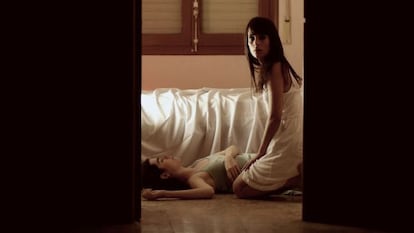Another Spanish cinema is possible
With film financing in crisis, moviemakers are resorting to guerrilla tactics


If the old subsidy system is broken, the new system of tax breaks to help productions hasn't kicked in and it is getting more and more difficult for a Spanish movie to get a theatrical release if it doesn't come from one of the majors - how do you make films in Spain today?
"Well, by getting out there and doing it for yourself," says director David Trueba. "In the current climate, that's the only way that I can shoot the things I want - by making sacrifices that, in return, give you the privilege of being able to tell your story."
His fellow filmmakers agree. "I have always done things this way: I set up my own theater company because you can't sit at home waiting for the phone to ring," says Paco León.
"If I wait around, I don't get to direct it," says Carlos Vermut.
The three are the directors of Madrid, 1987; Carmina o revienta and Diamond flash, respectively, all films that in recent months have created a stir in the media for their alternative approaches to financing.
They are not the only ones. Juan Cavestany has already shot and released two films on the internet: Dispongo de barcos - which also got a theatrical release - and El señor (www.dispongodebarcos.com). "This has given me a great deal of personal satisfaction, but people see it differently from a film that opens on a Friday on 200 screens - it's a marginal product."
You can't sit at home waiting for the phone to ring," says filmmaker Paco León
The old co-operative system is still alive, in recent years producing films such as WWW, which Javier Díez Moro, a former employee at state broadcaster RTVE, made by using 17,000 euros he had in a pension fund to set up a production company with other laid-off colleagues. Other systems, such as crowdfunding - involving the collection of thousands of small investments - are booming thanks to the internet, and the results are now here. El cosmonauta was the first, and now there are specialized crowdfunding platforms to be found online, such as Kifund.
But there are differences of scale even in this poverty-stricken sector of the industry. Madrid, 1987 cost Trueba 300,000 euros: "I shot it over 13 days and paid the technicians and the actors [José Sacristan and María Valverde] as if it were a big shoot. They later told me that some of them were paid less on their next jobs. I saved on the incidentals; I shot in real locations instead of building the bathroom on a set."
Paco León's mockumentary Carmina o revienta, which won the Special Jury Prize at Málaga, cost him 40,000 euros. "I invested the money I earned in television and advertising to get [artistic] freedom," he says.
Vermut, who came from the world of comics and TV, used the 25,000 euros he earned from creating animation series Jelly Jamm for Diamond flash, a brain-teasing story of women and a strange superhero. "I sent it to three producers, but I only waited a month. I wrote a script with just a few locations, just in case no one answered - which is exactly what happened. Scripts are organized better according to emotions, not logic. I saved on art and photography, and I gave priority to the plot and the actors." The average cost of a Spanish film is around three million euros.
Vermut and León describe themselves as naive. "I didn't show Diamond flash to any distributors," says Vermut.
"I believe in natural selection," says León. "If they liked it in Málaga, why not release it? The audience always ought to have the final word."
León denies it, but Alta Films has already announced it will distribute Carmina o revienta.
Trueba, meanwhile, is happy with the impact his film has had in terms of international sales and festivals: "Those who wanted to see it got to see it." A good commandment - and one that is seldom heard.
Tu suscripción se está usando en otro dispositivo
¿Quieres añadir otro usuario a tu suscripción?
Si continúas leyendo en este dispositivo, no se podrá leer en el otro.
FlechaTu suscripción se está usando en otro dispositivo y solo puedes acceder a EL PAÍS desde un dispositivo a la vez.
Si quieres compartir tu cuenta, cambia tu suscripción a la modalidad Premium, así podrás añadir otro usuario. Cada uno accederá con su propia cuenta de email, lo que os permitirá personalizar vuestra experiencia en EL PAÍS.
¿Tienes una suscripción de empresa? Accede aquí para contratar más cuentas.
En el caso de no saber quién está usando tu cuenta, te recomendamos cambiar tu contraseña aquí.
Si decides continuar compartiendo tu cuenta, este mensaje se mostrará en tu dispositivo y en el de la otra persona que está usando tu cuenta de forma indefinida, afectando a tu experiencia de lectura. Puedes consultar aquí los términos y condiciones de la suscripción digital.
Últimas noticias
From digital curfews to blocking apps: How technology experts protect their children online
Why the price of coffee has skyrocketed: from Brazilian plantations to specialty coffee houses
Confined to a Cuban hospital: When electricity is a matter of life or death
The complicated life of Francesca Albanese: A rising figure in Italy but barred from every bank by Trump’s sanctions
Most viewed
- Why we lost the habit of sleeping in two segments and how that changed our sense of time
- Trump’s obsession with putting his name on everything is unprecedented in the United States
- Pablo Escobar’s hippos: A serious environmental problem, 40 years on
- The Florida Keys tourist paradise is besieged by immigration agents: ‘We’ve never seen anything like this’
- Charles Dubouloz, mountaineering star, retires at 36 with a farewell tour inspired by Walter Bonatti








































